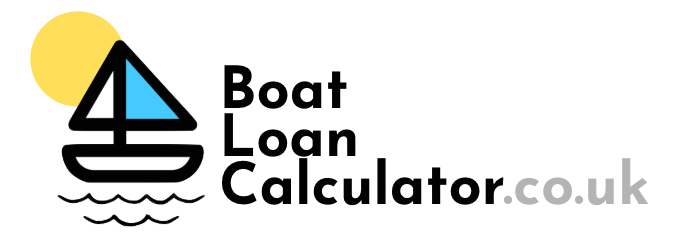Boat Loan Calculator
Use our free UK boat loan calculator to calculate the payment plan for your boat loan.

Boat Finance Calculator
Your Estimate
Enter loan details to see breakdown
Complete Guide to UK Boat Finance
Getting the Most from Your Boat Loan Calculator (5 Practical Tips)
1. Stress Test Your Interest Rate Set the interest rate 1-2 percentage points above current market rates or quoted offers. If your budget can handle this increase, you’ll have cushioning against potential market fluctuations and Bank of England base rate changes.
2. Factor in Total Running Costs Divide your estimated annual costs across 12 months and add to your monthly loan payment:
- Insurance (third party liability + comprehensive cover)
- Marina fees, winter storage, lifting/launching
- Maintenance, antifouling, cleaning
- Fuel, mooring fees, equipment (GPS, ropes, lifejackets, cleaning products)
- Emergency repairs fund (10-15% buffer recommended)
3. Plan for Early Sale Scenarios Calculate remaining loan balance after 24 or 36 months. Compare this conservatively to estimated resale value (err on the low side). If the gap is too narrow, consider a larger deposit or shorter loan term to avoid negative equity.
4. Test Different Deposit Amounts Try 10%, 20%, and 30% deposits in your calculator. Higher deposits typically secure better interest rates and reduce monthly payments significantly.
5. Consider Seasonal Payment Holidays Many UK lenders offer 1-3 month payment breaks during winter months. Factor this flexibility into your annual budgeting.
Essential Tips for UK Boat Buyers
The most important factor isn’t what lenders will approve, but what fits your lifestyle and budget. British waters offer incredible boating, but preparation prevents costly surprises.
1) Think Total Cost of Ownership, Not Just Monthly Payments
Beyond your loan payment, budget for:
Insurance Costs: Third party liability (minimum £3 million recommended) plus comprehensive cover. Consider agreed value policies for newer boats.
Marina and Storage: Annual berthing fees (£2,000-£8,000+ depending on location), winter storage, crane fees for lifting out.
Maintenance: Annual servicing, antifouling, engine maintenance, safety equipment checks. Budget 8-12% of boat value annually.
Operating Expenses: Fuel, harbour dues, canal licences (if applicable), equipment replacement.
RYA Training: Factor in costs for Day Skipper, Coastal Skipper, or specialist courses – essential for safe enjoyment and potentially lower insurance premiums.
Tip: Increase your calculator interest rate by 1% and reduce loan term by 12 months. If this still works for your budget, you’re better prepared for rate rises and unexpected costs.
2) Understanding UK Marine Finance Rates
Advertised Rate vs APR: Focus on the APR (Annual Percentage Rate) which includes all fees – arrangement fees, documentation costs, and any broker commissions.
Secured vs Unsecured: Secured loans (boat as collateral) typically offer rates from lower APR than unsecured loans. Unsecured personal loans have higher APR but offer more flexibility.
3) Deposit Strategy and Loan Terms
Deposit Benefits: 20-30% deposits often secure the best rates and reduce monthly payments substantially. Consider using existing savings or selling current boat.
Loan Terms: UK marine finance typically ranges from 5-20 years. Longer terms reduce monthly payments but increase total interest. Most lenders prefer maximum terms based on boat age and value.
Balloon Payments: Some packages offer lower monthly payments with a final balloon payment. Ensure you can refinance or have funds available at term end.
4) Types of UK Marine Finance
Secured Marine Loans: Boat acts as security. Typically higher APR than personal loans, longer terms available. Requires comprehensive insurance and sometimes marine survey.
Personal Loans: Faster approval, no marine survey needed, but higher rates and shorter terms. Good for older or lower-value boats.
Hire Purchase: Own the boat at end of agreement. Fixed monthly payments, but boat remains lender’s property until final payment.
Personal Contract Purchase (PCP): Lower monthly payments with optional final payment. Useful if you plan to upgrade regularly.
5) Pre-Application Essentials
Documentation Required:
- CE marking and Hull Identification Number (HIN)
- Registration documents (SSR or Part 1 if applicable)
- Service history and engine hours
- Marine survey (usually required for boats over £25,000)
Marine Survey: Essential for boats over £25,000. Costs £300-800 but can save thousands by identifying hidden problems. Many insurers require recent surveys.
Multiple Quotes: Obtain at least 3-4 comparable quotes simultaneously. Compare APR, loan terms, early repayment options, and payment holiday flexibility.
What Boats Can Be Financed in the UK?
Most recreational craft suitable for British waters can be financed:
Motor Boats: Bowriders, sports cruisers, flybridge boats, narrowboats, motor yachts. Lenders examine engine condition, maintenance history, and manufacturer reputation.
Sailing Yachts: Cruising and racing yachts from 20-80+ feet. Hull condition, rigging state, and sail inventory affect lending decisions.
RIBs and Sports Boats: Popular for their versatility and strong resale values. Tube condition and engine maintenance history crucial.
Personal Watercraft: Jet skis and similar craft, though loan terms may be shorter due to higher depreciation rates.
Narrowboats: Increasingly popular for lifestyle and holiday use. Lenders often require specialist marine surveys and continuous cruising licences where applicable.
Electric and Hybrid Craft: Growing market with good finance availability. Battery condition and warranty coverage are important factors.
Age and Value Limits: Most lenders finance boats up to 30 years old, minimum values around £15,000. Older or lower-value craft may require personal loans.
UK Boat Buyer’s Checklist
✓ Research true APR – compare all costs, not just headline rates
✓ Payment holidays – confirm winter break availability and terms
✓ Early repayment – understand process and any charges
✓ Insurance requirements – comprehensive cover levels and approved providers
✓ Survey requirements – when needed and approved surveyors
✓ Registration – SSR registration may be required for finance
✓ RYA membership – some lenders offer discounts for RYA members
Avoid Common Mistakes
Don’t focus solely on monthly payments. Include running costs, create a stress test scenario, and budget comprehensively for the full boating experience.
Don’t rush the marine survey. If you lack technical expertise, employ a qualified marine surveyor. The £500-800 cost can prevent expensive mistakes.
Study loan terms carefully. Obtain comparable quotes from multiple marine finance specialists, high street banks, and credit unions. Take time to understand all terms before accepting.
Be realistic about resale values. UK boat values can be volatile. Estimate conservatively and maintain emergency funds for unexpected repairs or maintenance.
Consider seasonal usage. Unlike some markets, UK boating is heavily seasonal. Factor this into your payment structure and budget planning.
When using online calculators, consider your boating plans holistically. Proper preparation ensures you find finance that enhances rather than restricts your enjoyment of British waters, from the Solent to the Scottish Highlands, Norfolk Broads to Welsh coastal waters.
Useful Resources
- RYA (Royal Yachting Association) – Training courses, certification, and member benefits
- UK Ship Register – Vessel registration with the Maritime and Coastguard Agency
- Financial Conduct Authority – Check if lenders are FCA regulated and understand your rights
- HM Coastguard – Safety information and emergency contacts
